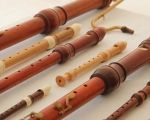- 1 - Understanding the Basics of Music Instruments
- 2 - Choosing the Right Instrument to Make for Your Skill Level
- 3 - Essential Materials and Tools Needed for Making Music Instruments
- 4 - Step-by-Step Process to Make Your Music Instrument
- 5 - Tips to Improve Sound Quality and Playability
- 6 - Inspiring Stories from DIY Instrument Makers
- 7 - Where to Find Resources and Support for Music Instrument Making
1. Understanding the Basics of Music Instruments
Before diving into how to make a music instrument, it’s crucial to understand the fundamentals of how musical instruments produce sound. Instruments generate sound through vibration, which can come from strings, air columns, membranes, or even surfaces. Recognizing this helps in choosing the right design and materials.
For example, string instruments like guitars and violins rely on vibrating strings stretched over a resonant body, while percussion instruments depend on striking a surface. This basic knowledge influences every decision you make during the building process.
The importance of sound mechanics
Knowing how vibration and resonance work can guide your construction choices—whether it’s the wood thickness, string tension, or the shape of the resonator. This insight is essential for crafting an instrument that sounds good and is enjoyable to play.
2. Choosing the Right Instrument to Make for Your Skill Level
When learning how to make a music instrument, selecting one that matches your skills and available resources is key. Beginners often start with simple designs like a cajón drum, a kalimba, or a cigar box guitar, as these require fewer complex parts and tools.
For those with some woodworking or crafting experience, stringed instruments such as ukuleles or small violins offer a rewarding challenge. Electronic instruments or synthesizers can be explored later, given their need for electronic components and technical know-how.
Assessing your goals and available time
Consider whether you want the instrument primarily for decoration, casual play, or serious music-making. This goal shapes how detailed and precise you’ll need to be during the construction phase.
3. Essential Materials and Tools Needed for Making Music Instruments
Depending on the instrument you choose, your materials will vary, but some basics remain consistent:
Materials
- Wood: plywood, hardwood, or softwood for bodies and necks
- Strings or membranes: guitar strings, rubber bands, or drum skins
- Adhesives: wood glue or strong craft glue
- Hardware: tuning pegs, screws, nails, frets
- Finishing supplies: sandpaper, paint, varnish
Tools
- Basic hand tools: saws, chisels, files, screwdrivers
- Power tools (optional but helpful): drills, rotary tools
- Measuring instruments: rulers, calipers, protractors
Beat Trigger offers curated selections of materials and tools specifically suited for crafting high-quality instruments, helping beginners avoid common pitfalls.
4. Step-by-Step Process to Make Your Music Instrument
While each instrument has unique steps, the general process includes:
Step 1: Design and planning
Start by sketching your instrument’s blueprint or finding existing plans. Accurate measurements and clear design help avoid mistakes.
Step 2: Material preparation
Cut and shape your wood or base materials carefully. Smooth rough edges with sandpaper and prepare surfaces for assembly.
Step 3: Assembly
Follow your design to join parts securely using glue, screws, or nails. Precision here ensures structural integrity and sound quality.
Step 4: Adding functional elements
Install strings, membranes, or keys, depending on your instrument. For stringed instruments, tuning pegs and fret placement are critical.
Step 5: Finishing touches
Apply varnish or paint for protection and aesthetics. Allow drying time and test your instrument’s sound and playability, making adjustments as needed.
5. Tips to Improve Sound Quality and Playability
Sound quality often depends on the materials used and construction accuracy. Here are some tips:
Use quality wood and materials
Denser woods tend to produce richer tones, while poor-quality materials can result in muffled or uneven sounds.
Maintain proper tension
Whether tuning strings or stretching drum skins, appropriate tension ensures clear and consistent sound.
Experiment with resonators
Resonating chambers amplify sound. Trying different shapes and sizes can significantly change your instrument’s character.
Test and adjust regularly
Build in time to play-test and refine. Small tweaks can make a big difference in tone and comfort.
6. Inspiring Stories from DIY Instrument Makers
Across online communities, many have shared remarkable stories about building instruments from scratch. One viral story features a young musician who crafted a fully functional electric guitar from recycled materials, using household tools and a bit of creativity. Their journey inspired thousands to pursue instrument making as a creative outlet.
Another popular case is of a family that bonded over making a drum set from found objects like buckets and cans during the pandemic, proving music’s power to bring people together even in challenging times.
7. Where to Find Resources and Support for Music Instrument Making
Learning how to make a music instrument can be greatly enhanced by tapping into the right resources. Online tutorials, forums, and communities provide invaluable guidance and feedback. For those looking for curated tools, parts, and professional advice, Beat Trigger offers tailored solutions and expert support to help bring your DIY musical projects to life.
Whether you are a beginner or a seasoned hobbyist, the journey of making your own instrument can be deeply rewarding, fostering creativity and a stronger connection to music.








